
Crown jewels are the objects of metalwork and jewellery in the regalia of a current or former monarchy. They are often used for the coronation of a monarch and a few other ceremonial occasions. A monarch may often be shown wearing them in portraits, as they symbolize the power and continuity of the monarchy. Additions to them may be made, but, since medieval times, the existing items have been typically passed down unchanged, symbolizing the continuity of a monarchy.
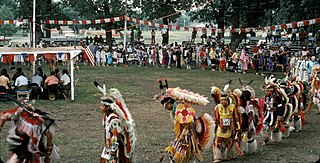
A powwow is a gathering with dances held by many Native American and First Nations communities. Inaugurated in 1923. Powwows today are an opportunity for Indigenous people to socialize, dance, sing, and honor their cultures. Powwows may be private or public, indoors or outdoors. Dancing events can be competitive with monetary prizes. Powwows vary in length from single-day to weeklong events.

The Crown Jewels of the United Kingdom, originally the Crown Jewels of England, are a collection of royal ceremonial objects kept in the Jewel House at the Tower of London, which include the coronation regalia and vestments worn by British monarchs.

St Edward's Crown is the coronation crown of the Crown Jewels of the United Kingdom. Named after Saint Edward the Confessor, versions of it have traditionally been used to crown English and British monarchs at their coronations since the 13th century. It is normally on public display in the Jewel House at the Tower of London.
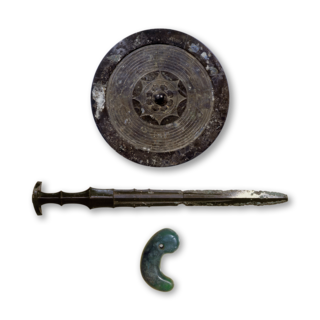
The Three Sacred Treasures are the imperial regalia of Japan and consist of the sword Kusanagi no Tsurugi (草薙劍), the mirror Yata no Kagami (八咫鏡), and the jewel Yasakani no Magatama (八尺瓊勾玉). They represent the three primary virtues: valour, wisdom, and benevolence. The actual historical status of these legendary treasures is unknown as they are intentionally kept from public view to symbolize authority.

Hot Rats is the second solo album by Frank Zappa, released in October 1969. It was Zappa's first recording project after the dissolution of the original lineup of the Mothers of Invention. Five of the six songs are instrumental, while "Willie the Pimp" features vocals by Captain Beefheart. In his original sleeve notes, Zappa described the album as "a movie for your ears".

A bustle is a padded undergarment or wire frame used to add fullness, or support the drapery, at the back of women's dresses in the mid-to-late 19th century. Bustles are worn under the skirt in the back, just below the waist, to keep the skirt from dragging. Heavy fabric tended to pull the back of a skirt down and flatten it. As a result a woman's petticoated skirt would lose its shape during everyday wear.
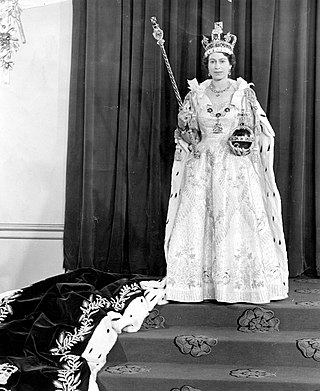
Regalia is the set of emblems, symbols, or paraphernalia indicative of royal status, as well as rights, prerogatives and privileges enjoyed by a sovereign, regardless of title. The word originally referred to the elaborate formal dress and accessories of a sovereign, but now it also refers to any type of elaborate formal dress. The word stems from the Latin substantivation of the adjective regalis, "regal", itself from rex, "king". It is sometimes used in the singular, regale.

Fancy dance, Pan-Indian dancing, Fancy Feather or Fancy War Dance is a style of dance some believe was originally created by members of the Ponca tribe in the 1920s and 1930s, in an attempt to preserve their culture and religion. It is loosely based on the war dance. Fancy dance was considered appropriate to be performed for visitors to reservations and at "Wild West" shows. But today, fancy dancers can be seen at many powwows across the nation and even the world.

The Imperial Regalia, also called Imperial Insignia, are regalia of the Holy Roman Emperor. The most important parts are the Crown, the Imperial orb, the Imperial sceptre, the Holy Lance and the Imperial Sword. Today they are kept at the Imperial Treasury in the Hofburg palace in Vienna, Austria.
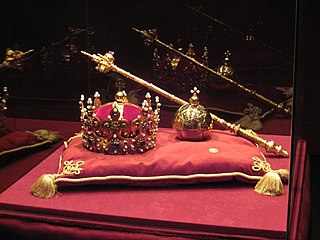
The only surviving original piece of the Polish crown jewels from the time of the Piast dynasty is the ceremonial sword Szczerbiec. It is currently on display along with other preserved royal items at the Wawel Royal Castle Museum in Kraków.

The regalia of the Netherlands consists of a number of items symbolising the Dutch monarch's authority and dignity. In comparison to many European monarchies' regalia, the Dutch regalia are relatively new: having been commissioned by King William II in 1840. An earlier, more modest set of regalia made of silver was commissioned by King William I in 1815.

As the oldest college in the United States, Harvard University has a long tradition of academic dress. Harvard gown facings bear crow's-feet emblems near the yoke, a symbol unique to Harvard, made from flat braid in colours distinctive of the wearer's qualification or degree. Crow's-feet are double for earned degrees, and triple for honorary degrees.
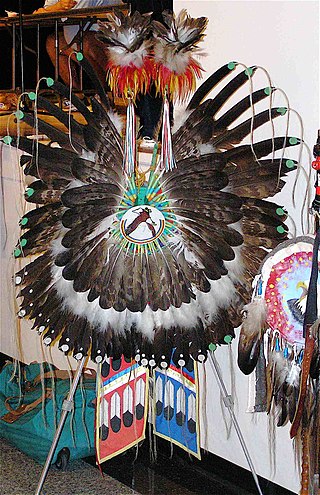
The Native American bustle is a traditional part of a man's regalia worn during a dance exhibition or wachipi and originates from the Plains region of the United States. In its modern form, the men's bustle is typically made of a string of eagle or hawk feathers attached to a backboard. Eagle and hawk feathers are sacred religious objects to Native American people and the possession of eagle and hawk feathers are protected by the eagle feather law.

Napoleon I and his wife Josephine were crowned Emperor and Empress of the French on Sunday, December 2, 1804, at Notre-Dame de Paris in Paris. It marked "the instantiation of [the] modern empire" and was a "transparently masterminded piece of modern propaganda". Napoleon wanted to establish the legitimacy of his imperial reign with its new dynasty and nobility. To this end, he designed a new coronation ceremony unlike that for the kings of France, which had emphasised the king's consecration (sacre) and anointment and was conferred by the archbishop of Reims in Reims Cathedral. Napoleon's was a sacred ceremony held in the great cathedral of Notre Dame de Paris in the presence of Pope Pius VII. Napoleon brought together various rites and customs, incorporating ceremonies of Carolingian tradition, the ancien régime, and the French Revolution, all presented in sumptuous luxury.

The grass dance or Omaha dance is a style of modern Native American men's pow wow dancing originating in the warrior societies on the Northern Great Plains. Unlike most forms of pow wow dancing, the grass dance regalia generally has no feathers besides the occasional roach feather. The regalia consists of brightly colored fringe made of either yarn, broadcloth, or ribbon.
Bustle is an online American women's magazine founded in August 2013 by Bryan Goldberg. It positions news and politics alongside articles about beauty, celebrities, and fashion trends. By September 2016, the website had 50 million monthly readers.

The academic regalia of Columbia University are the robes, gowns, and hoods which are prescribed by the university for its graduates. As one of the oldest universities in the United States, Columbia University has a long tradition of academic dress dating back to its founding in the 18th century, when it became the second university in the country to formally adopt academic robes. The development of Columbia's academic regalia has strongly influenced those of most universities in the United States. Since the passing of the Intercollegiate Code of Academic Costume in 1895, the style of academic dress worn at the university in the late 20th century has served as the basis of those of most other universities in the country. Though once worn daily by students at the university, caps and gowns now are only worn during commencement.















